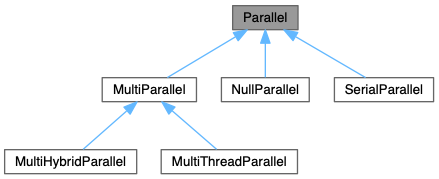#include <Parallel.hpp>

Public Member Functions | |
| virtual | ~Parallel () |
| virtual void | call (size_t maxIndex, std::function< void(size_t firstIndex, size_t numIndices)> target)=0 |
Protected Member Functions | |
| Parallel () | |
Parallel is an abstract base class for subclasses that implement various parallelization schemes using one or more execution threads and/or one or more processes in an MPI group.
A Parallel subclass instance can be created only through the parallel() function of the ParallelFactory class. This function constructs the appropriate Parallel subclass instance depending on the requested task allocation mode and the available parallel resources. The client accesses the returned Parallel subclass instance using the common interface defined in this abstract base class.
The call() function offered by this interface executes a specified target function \(N\) times as if it were part of a for loop over a range of indices from zero to \(N-1\). Each index in the range represents a particular task. To reduce the overhead of handing out the tasks, the loop is actualy chopped into chunks of consecutive indices. Rather than a single index, the target function is handed the first index of the chunk and the number of indices (tasks) in the chunk, and it is expected to iterate over the specified index range. The chunk sizes are determined automatically to achieve optimal load balancing given the available parallel resources, while still maximally reducing the overhead of handing out the chunks.
Because it may be invoked from multiple parallel threads, the target function should protect (write) access to shared data through the use of some synchronization mechanism. Shared data includes essentially everything other than local variables. Also note that this requirement also holds for all functions directly or indirectly called by the target function.
A particular Parallel subclass instance can be reused for calling various target functions, reducing the overhead of creating and destroying the resources employed by the parallelization schem. One can also use multiple Parallel instances in a program. For example, a parallelized target function can invoke the call() function on another Parallel subclass instance that is requested from a ParallelFactory constructed and destructed within the scope of the target function. Recursively invoking the call() function on the same Parallel instance is not allowed and results in undefined behavior.
|
inlineprotected |
The constructor is declared protected because this is an abstract class. At the level of this abstract class, the constructor does not do anything.
|
inlinevirtual |
Destructs the instance and releases all resources. At the level of this abstract class, the destructor does not do anything.
|
pure virtual |
This function calls the specified target function repeatedly for index chunks that, taken together, will exactly cover the index range from zero to maxIndex-1. Each index chunk is specified to the target function through its two arguments, firstIndex and numIndices. The invocations of the target function will be distributed over the parallel resources in an unpredicable manner, and the various index chunks may be processed in arbitrary order.
The index chunk sizes are determined automatically to achieve optimal load balancing given the available parallel resources, while still maximally reducing the overhead of handing out the chunks.
Implemented in MultiHybridParallel, MultiThreadParallel, NullParallel, and SerialParallel.